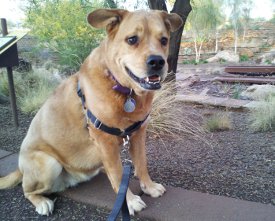
As a dog owner, one of the best things you can learn is how to train a dog to walk on a leash. Walking together enhances the bond between dog and owner, provides exercise, and allows the dog to accompany you on visits to dog-friendly places. All of these are much more enjoyable when your dog walks calmly and isn’t trying to drag you down the street.
The secret to accomplishing this is teaching your dog it’s more rewarding to walk beside you than to pull ahead. This takes teaching him about two things: tension and patience.
Avoiding Leash Tension
When a dog pulls, there is constant tension on the leash. You want your dog to understand that a loose leash is preferable. How do you do this?
Begin by not allowing your dog to grow accustomed to tension on the leash. If your dog pulls, do not pull backwards in an attempt to stop the pulling. Dogs innately pull against whatever is pulling them, so pulling backwards will only encourage him to pull forwards and get used to constant tension. Instead, give a quick, sharp tug on the leash (but never so strong your dog is lifted off his feet). This will get his attention more effectively.
Second, do not use a retractable leash while training your dog to walk beside you. They have their uses, but the constant pull of the gadget creates tension on the leash. Train with a fixed-length leash.
Teaching Patience
Many dogs pull because they are anxious to see what’s ahead. You want to teach your dog that he will be rewarded for his patience. There are a few ways to accomplish this.
First, show your dog impatience is not rewarded. As soon as your dog pulls forward, say “ah!” or “no!” loudly with a quick tug on the leash to get his attention and communicate that pulling is not ok. If he continues to pull, simply turn and walk in the opposite direction. That shows him that when he pulls, he doesn’t get ahead faster - he ends up further behind. Now, your dog is behind you and will walk towards you. As your dog approaches, say “heel” and praise him when he is at your side. Here’s where the technique gets really useful. If he starts to walk ahead of you, you can stop him and turn around before there’s tension on the leash from his pulling. This gets him used to a loose leash. If he pulls again, repeat this process as many times as necessary. It may get frustrating but it is very effective for training your dog to walk calmly on the leash.
Then, show him the benefits of walking calmly at your side. When he is beside you, say “heel” to associate his position with the word. Reward him with praise. For food-motivated dogs, dropping a training treat is an excellent option. He gets a treat by walking beside you and does not get treats when he is pulling ahead. This gives him great motivation for staying beside you (think of the dog that learns to stay beside the dinner table to catch crumbs).
Putting It Together
As you train your dog to walk on a leash, remember: the training is the focus of the walk, not the distance. If you spend 20 minutes taking a few steps then turning around because your dog is pulling, it’s not a failure. It’s progress towards your dog learning that pulling is not rewarded.
Reward your dog when he is at your side, even if it’s for a few moments. That will show him where you want him to be. With consistent praise and continuous forward motion when at your side, your dog will learn that he will get what he wants by doing what you want.
Don’t be afraid to use training tools to speed up the training. If your dog is food-motivated, keep training treats on hand. If your dog is a serious puller, use a no pull dog harness (shown above) to encourage him to stay beside you. Remember above when we said dogs instinctively pull against whatever pulls them? The no pull dog harness connects in the front, pulling the dog forward with a tug on the leash. Instinctively, the dog moves backwards – stopping the pulling. If treats and a harness are what your dog needs to understand where you want him to be, use it. Click here to order a dog harness no pull set.
Finally, be consistent. Don’t allow any pulling; you’ll confuse your dog about what’s ok and what’s not. Even if you feel like you’re not making progress, continue to work on this daily. Your dog will learn how to walk on a leash more quickly if you work on it consistently. Otherwise, he’ll forget the lesson between sessions.
Here’s the secret of how to train a dog to walk on a leash: show your dog that it is more rewarding to walk calmly at your side than to pull ahead impatiently. Use these tips and you’ll soon be enjoying calm walks with your dog.
If you liked this, you may also like:
How To Get My Dog To Stop Barking
Dog Leashes For Large Dogs
Dog Training With Hand Signals
|